Buying a new home? Consider downsizing.
Loading...
Recently, I was browsing through my journals from early 2007, the period when Sarah was pregnant with our second child and we realized that we needed a larger home. We spent a lot of our time in that period house-hunting. We had really turned our finances around over the previous year, and The Simple Dollar was beginning to become popular, so it was a very interesting time.
In my journals, I tried to keep notes on the houses we looked at. When I reflect on that time, I really only remember looking at a handful of houses, but my notes show me that we looked at a lot of houses.
So, what’s interesting about that? The first ten houses we looked at were all at least $50,000 more expensive than the house we ended up buying.
Our initial assumptions about the house we needed were very much on the high end. We were looking at houses with five bedrooms, huge amounts of open space on the lower floor, basements that were either finished into a giant parlor or could be finished in such a way, amazing open kitchens with huge islands, and so forth.
These are things that we desired in a home, but honestly, we didn’t need them, particularly in our first home.
What changed our minds? A few things did.
First, we sat down and talked about what we actually needed in a house at that time. Although we really wanted all kinds of neat things, we didn’t need them. We needed three or maybe four bedrooms. We didn’t need a really big kitchen. We only needed a single modestly-sized family gathering room.
Everything else, when we got right down to it, was unnecessary.
Our second clue was when we seriously calculated what our homeowner expenses would look like. Insurance was much higher. We’d be facing property taxes. Our utility bills would jump. Our actual cost of living there would also jump, as our rent in our small apartment was quite a bit lower than our expected mortgage payments. Any repairs would come out of our pocket, not that of the landlord.
It’s not just a matter of comparing your mortgage bill to your rent. Home ownership comes with quite a few additional expenses that you’ll have to deal with.
For us, the final straw was a serious talk with our lender. She was quite happy to lend us any amount we asked for, but our lender actually had a conscience. She told us that in good conscience she wouldn’t sign off on a large preapproval, but only one for a relatively small amount. Why? On paper, it was an acceptable risk for the bank, but in reality, it was a pretty big risk for them – and for us, too. Home ownership is financially hard, especially at first.
Our lender was right, and I truly wish all lenders acted with such responsibility during the housing bubble.
After that, we started searching in our own price range, and we eventually found a perfect house that really met our needs that was well within a reasonable price range for us. We’ve lived here for several years and couldn’t be happier with our decision.
When you’re shopping for a house, particularly your first one, you don’t need the house you think you do. Aim lower. You’ll find that you won’t be choked by your finances and that the house actually works really well for you. Build up some equity and maybe in a few years you can move on to the house of your dreams. It’s a far better path than the tightrope walk that comes with a house that exceeds your means to easily pay for it.






